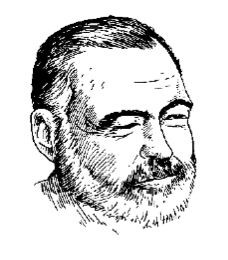The possibility that becoming the most distinctive American prose writer of the twentieth century would have its considerable drawbacks probably did not occur to the twenty-seven-year-old author of The Sun Also Rises when it was published in 1926. Despite some powerful literary advocates, Hemingway’s first two books had flopped; copies were not even available in Hemingway’s hometown of Oak Park, Illinois. His third book—a cocky, strutting, elliptical novel about British and American expatriates behaving as badly as their times (and Hemingway’s censors) allowed them—changed all that. As Lionel Trilling wrote only thirteen years after Sun’s publication, Hemingway, “more than any writer of our time… has been under glass, watched, checked up on, predicted, suspected, warned.” The book’s much-heralded style, as liberating as a magic spell for its author, eventually became a kind of aesthetic stockade. By 1961 serial shock treatments at the Mayo Clinic had left the arch mage depressed, unable to write, needlessly lecturing his wife about her “expenses,” and convinced that the FBI was reading his mail and wiretapping his phone. Hemingway’s suicide of that year was not only an act of escape from the various furies, real and imagined, in steady pursuit of him; it was the explosive period to the only sentence he could bring himself to compose. For this reason any writer who has been compared to Hemingway feels a certain clammy shudder: as it turned out, not even Hemingway could survive the comparison.
The bright student who picks up The Sun Also Rises today cannot be wholly blamed for finding its opening pages somewhat cinched and joyless, in the manner of a man playing badminton in a tuxedo. We should be glad that Hemingway, on F. Scott Fitzgerald’s suggestion, dumped Sun’s original and singularly leaden opening: “This is a novel about a lady. Her name is Lady Ashley and when the story begins she is living in Paris and it is Spring.” An assumed conservatism is the fate of nearly all books that become classics, though few are less deserving of that fate than The Sun Also Rises. The opening Hemingway ultimately went with (“Robert Cohn was once middleweight boxing champion of Princeton”) ranks among literature’s great misdirects. The Sun Also Rises really is a novel about a lady. Cohn is merely one of her four suitors, though he suffers the most because of it.
Lady Brett Ashley, recently divorced, presently engaged, frequently drunk (or “tight,” in Hemingway’s parlance), and doggedly promiscuous, is one of American fiction’s more striking heroines. Like Hamlet, she controls the action even by her absence. The novel’s narrator, Jake Barnes, loves her, but cannot consummate...
You have reached your article limit
Sign up for a digital subscription and continue reading all new issues, plus our entire archives, for just $1.50/month.
Already a subscriber? Sign in





